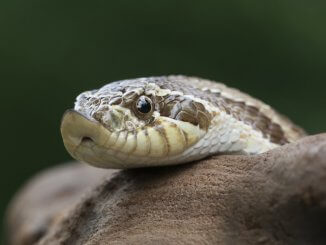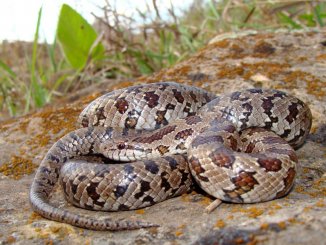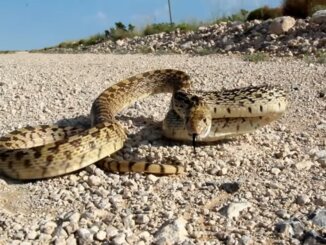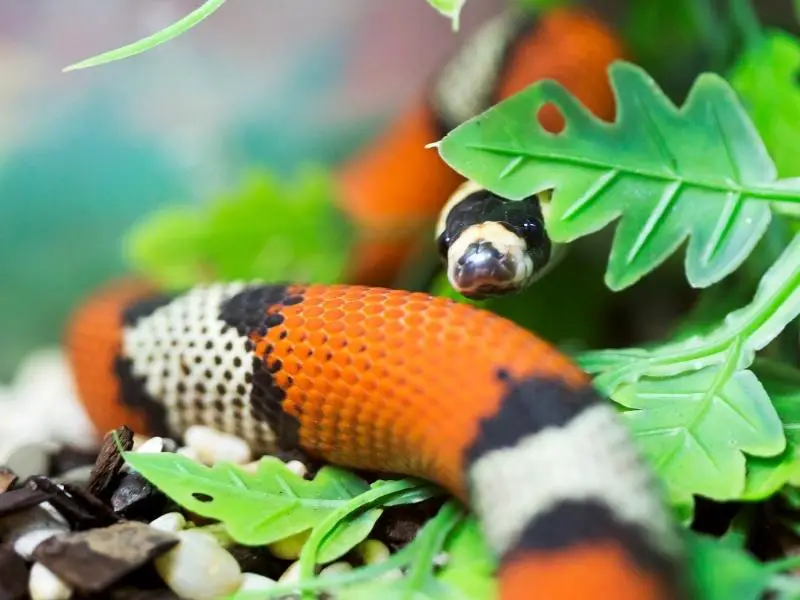
The Honduran milk snake is a large species of milk snake that grows between 5 feet and 6 feet long on average. These snakes are found in tropical regions of Honduras, Costa Rica, and Nicaragua.
Honduran milk snakes are known for their red, white, and black stripes. The snakes aren’t usually violent to humans, and the snakes are moderately easy to care for.
Honduran Milk Snake Overview
| Common name | Honduran milk snake |
| Scientific name | Lampropeltis triangulum hondurensis |
| Natural habitat | Subtropical regions of Honduras, Nicaragua, and Costa Rica |
| Adult size | 5–6 feet long |
| Average lifespan | 15–20 years |
| Diet | Mice and rats |
| Housing | A minimum 3 x 2 x 2-foot wooden vivarium with ⅓ of the tank at 90°F as a basking area, and the rest of the tank at 70°F |
| Experience | Beginner |
Origin
The Honduran milk snake (Lampropeltis triangulum hondurensis) is found in forest floor and grassland habitats throughout the subtropical areas of Honduras, Nicaragua, and the north of Costa Rica.
Because these snakes originate in warm habitats, it’s important that the reptile’s tank conditions mimic this heat.
Appearance and Behavior
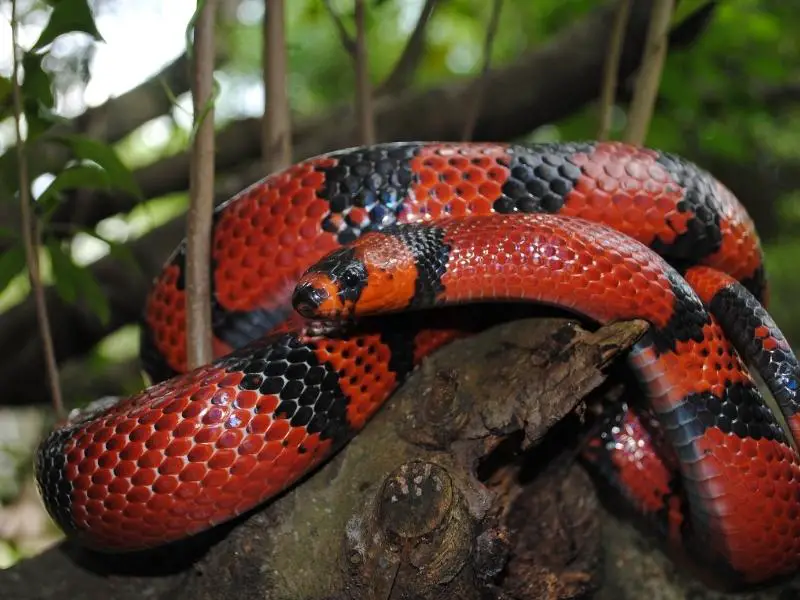
Honduran milk snakes are well-known for their three-banded stripes colored red, black, and white or cream. The tangerine morph milk snake species has a light orange stripe in place of the red stripe. Female Honduran milk snakes tend to be larger than males.
The Honduran milk snake is brightly colored to convince potential predators that it’s venomous, although the snake carries no venom. Male and female Honduran milk snakes look very similar, so it’s hard to tell the genders apart.
Size and Lifespan
Honduran milk snakes have narrow bodies and, on average, measure between 5 and 6 feet long. These snakes can live up to 20 years old in captivity if properly looked after.
Temperament
Honduran milk snakes are typically docile and unlikely to act violently towards people. This breed of snake can be shy and is most active at night. Herpetoculturists shouldn’t keep the Honduran milk snakes for display.
Housing Honduran Milk Snakes
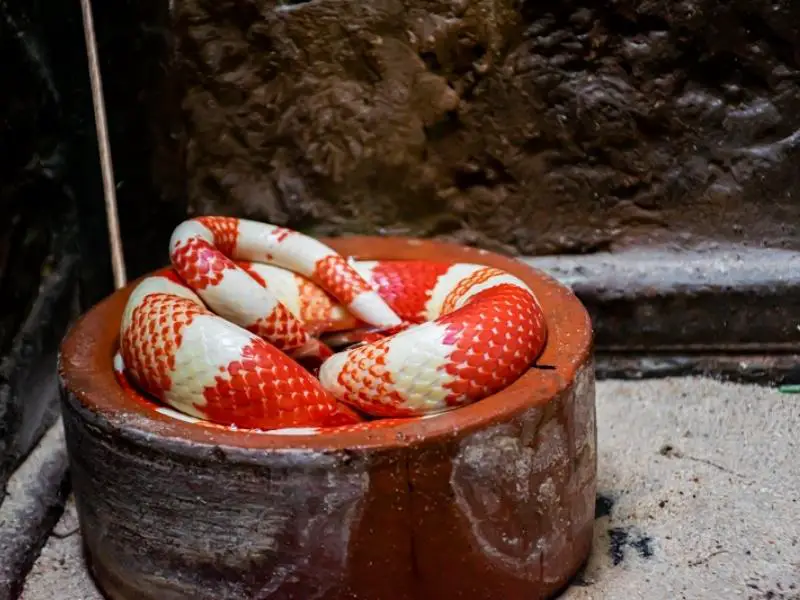
The basking area in the Honduran milk snake’s tank should reflect the species’ warm habitat in the wild. Keep the snakes in a vivarium with a tight lid because these snakes are known to be good at escaping.
The snake should be housed alone because it’s known to show aggression to other snakes and may eat snakes of the same species. Honduran milk snakes tend to be docile towards humans.
Enclosure size
This species needs a moderately-sized enclosure of at least 3 x 2 x 2 cubic feet. Younger snakes can survive in a slightly smaller vivarium.
Lighting
Use a UVB light in the Honduran milk snake’s closure to more closely replicate the species’ natural habitat.
To support the snake’s nocturnal rhythm, provide ambient daytime lighting on a 12-hour timer.
Temperature and Humidity
The humidity range in the snake’s tank should be kept at around 50% to support the snake’s shedding process. Monitor the tank’s humidity using a hygrometer.
Different parts of the tank should be at different temperatures. Create a basking area of between 80 and 90°F by using a heating pad or lamp, and keep the rest of the tank at 70°F.
Substrate and Decoration
Use substrate in the Honduran milk snake’s terrarium that allows the snake to carry out its natural burrowing and rooting behaviors. Cypress is a good substrate choice because it holds humidity well. Other popular substrate options are mulched paper, aspen, and orchid bark.
Provide this timid snake with lots of hiding places, such as caves, fake plants, branches, and cover decorations. Honduran milk snakes prefer shade and shelter over open space.
Ensure mold and bacteria growth in the tank is kept low by cleaning the tank frequently. To help prevent bacteria growth use a vivarium with adequate ventilation and avoid keeping the snake in a bioactive enclosure. A bioactive enclosure includes living elements such as plants and fungi that work together like a self-sustaining ecosystem within the tank.
Cleaning
Keep the Honduran milk snake happy by keeping its tank clean. Clean the tank once a week and completely change the substrate every few weeks.
To clean the enclosure, remove the snake and all the tank’s decorations and substrates. Clean decorations and all surfaces in the empty tank with a reptile-friendly disinfectant. Follow the disinfectant instructions and wipe away residues with a paper towel.
Clean the tank during the day to allow the snake to bask for at least one hour after being returned to the tank before the basking lamps are switched off for the night. This basking time will prevent the snake from getting too cold.
Do not remove the snake from the tank immediately before or after eating because the snake may bite, regurgitate its food if it has just eaten, or may be reluctant to eat.
Honduran Milk Snake Care
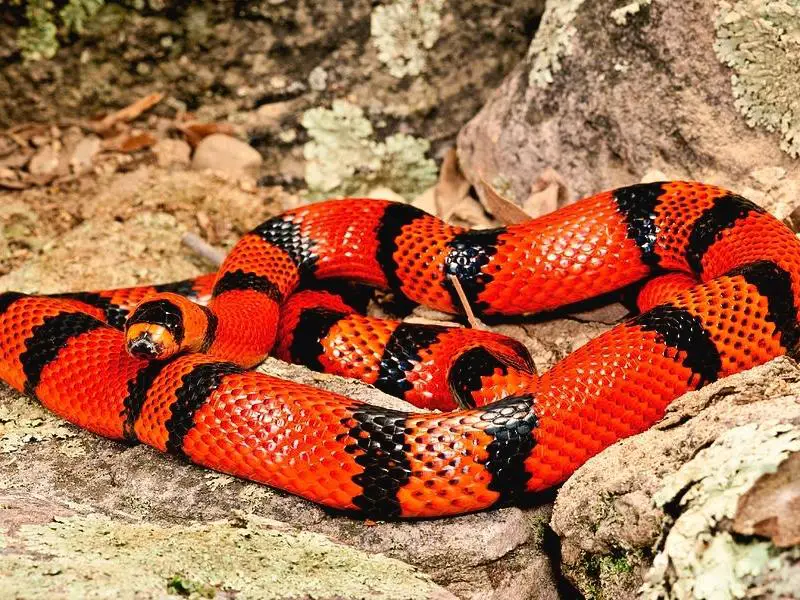
As long as the Honduran milk snake receives the right environment in its tank, this species is relatively easy to look after.
Food and Water
Honduran milk snakes are carnivorous and thrive on a diet of mice and rats. Rodents should be bought frozen and then thawed before being fed to the snake. Don’t feed Honduran milk snakes live rodents.
A snake hatchling should be fed one defrosted mouse weekly. As the snake grows, increase the food size until the milk snake is an adult and can eat large mice and rats. Adult Honduran milk snakes should be fed every two weeks to avoid the snake becoming overweight.
Honduran milk snakes need a constant source of clean water in a large bowl. Keep the bowl of water on the cooler side of the tank to avoid increasing the tank’s humidity. The snake may occasionally bathe in the tank to cool off.
Handling
Honduran milk snakes can be nervous as babies and are prone to whipping their tails or biting as a threat to potential predators. With regular gentle handling, the snake should be less prone to these behaviors when it matures.
When handling the snake, support the bulk of its body and avoid putting your hand near its head. Allow the snake to climb on you and explore its environment. Don’t handle the snake directly before or after feeding it, and wash your hands before handling it so the snake doesn’t consider your fingers as food.
Common Health Issues
Snakes are commonly affected by parasites like ringworm, mites, and ticks. Signs that the snake has a parasite include the snake becoming sluggish or lethargic or developing spots on its body. Seek advice from a veterinarian if you notice these symptoms.
Honduran milk snakes are also affected by mouth rot, which comes from an overgrowth of bacteria in the mouth. Snakes with mouth rot show little interest in food and have pus, discharge, or blood in their mouths. To treat mouth rot, take your snake to the veterinarian for antibiotics and a thorough mouth cleaning.
Breeding
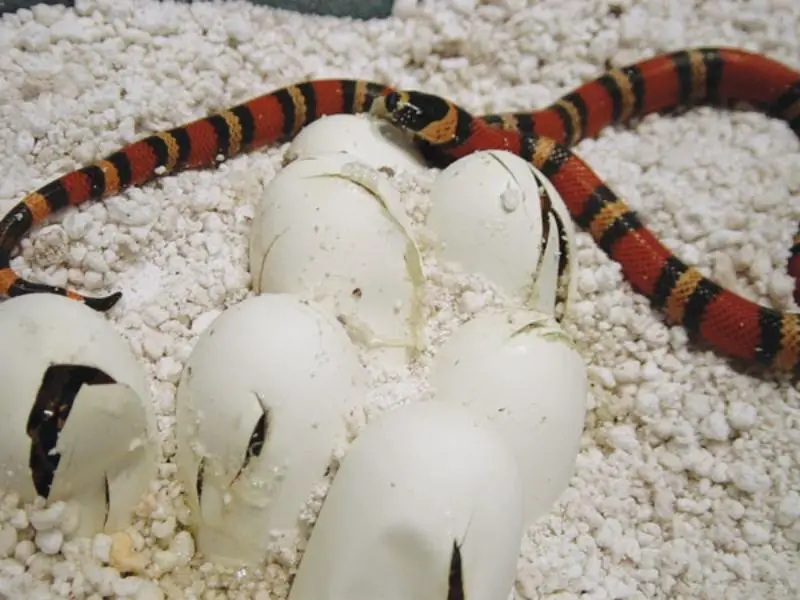
If you keep a female and male Honduran milk snake together, they may breed.
Provide a nesting box in the tank that’s large enough for the female to turn around in. If the snakes mate, the female will lay her eggs in the nesting box. Line the floor of the nesting box with a soil mix that’s humid enough to keep its shape but not wet enough to saturate the eggs.
Once the female lays eggs, move the eggs to an incubator at 84°F, with a moisture-rich substrate to maintain high humidity. Some of the eggs may stick together and separation can harm the snake embryo.
The eggs will hatch after about two months. Move the hatchlings to a 10-gallon or larger enclosure. After around two weeks, the hatchlings will shed for the first time and should be fed their first small defrosted mouse.
You can choose to keep the hatchlings together or separate them. If you keep them together, watch them vigilantly and separate the baby snakes immediately if you see displays of aggression.
Choosing and Buying a Honduran Milk Snake
A Honduran milk snake typically costs between $100 and $250. It’s recommended to buy these snakes from a reputable breeder or a reptile store. This snake is relatively widely available in reptile specialist stores.
When buying a Honduran milk snake, ask the breeder about the snake’s family history to determine the risk of genetic diseases. Snakes that look lethargic or sluggish or have signs of infection, such as discharge from the mouth or spots all over the body, should be avoided.

